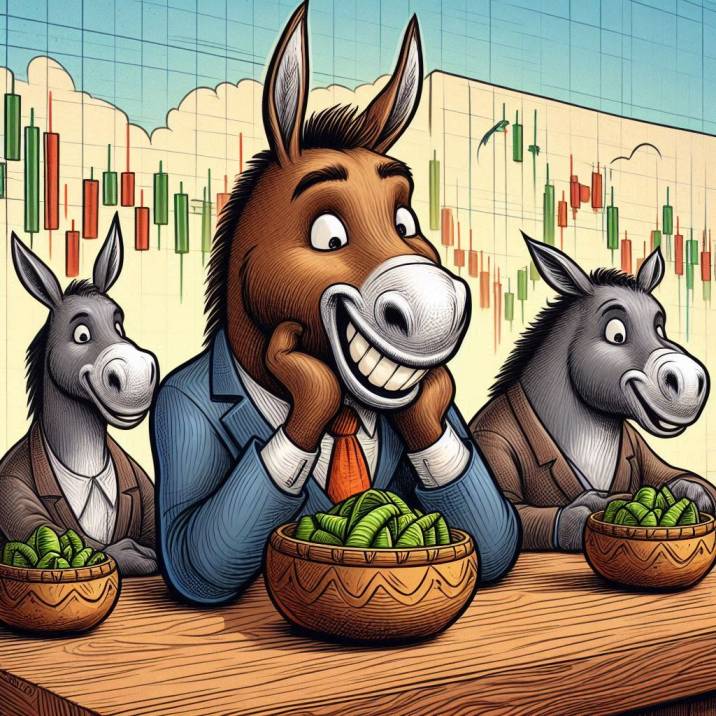
Overtrading: The Perfect Burro Formula for Financial Failure
Oct 23, 2024
The Siren Song of Market Euphoria
Picture this: It’s December 1999, and a taxi driver in New York City is enthusiastically sharing hot stock tips with his passengers, confidently explaining how his day-trading strategy has outperformed veteran Wall Street analysts. Fast forward to 2007, when real estate agents assure buyers that housing prices can only go up, making any purchase a “sure thing.” These snapshots capture moments just before two of history’s most spectacular market crashes, illustrating a timeless truth: disaster usually lurks around the corner when everyone thinks they’re a market genius.
The Psychology Behind the Madness
Behavioural economists have long studied the fascinating phenomenon of mass market psychology. Nobel laureate Daniel Kahneman, alongside Amos Tversky, revolutionized our understanding of decision-making through their prospect theory. This theory demonstrates how humans are inherently loss-averse yet paradoxically prone to risk-seeking behaviour when chasing losses. This psychological quirk explains why investors often compound their mistakes through overtrading, desperately trying to recover losses while digging deeper into financial holes.
Dr Richard Peterson, a leading expert in behavioural finance, notes that the human brain processes financial losses in the same regions that respond to mortal danger. This primitive response triggers fight-or-flight mechanisms, leading to panic selling during market downturns and impulsive buying during upswings. The result? It is a perfect recipe for transforming rational investors into market “burros,” perpetually carrying the heavy burden of poor timing and emotional decision-making.
The Technical Tango: When Numbers Meet Emotions
While psychology drives market behavior, technical analysis provides the tools to quantify and predict these movements. Legendary technical analyst John Bollinger, creator of the Bollinger Bands, emphasizes that markets operate in cycles of fear and greed. When properly analysed, these emotions create recognizable patterns that can help investors avoid the overtrading trap.
Consider the Relative Strength Index (RSI), a powerful technical indicator measuring recent price changes’ speed and magnitude. When the RSI reaches extreme levels (above 70 or below 30), it often signals market conditions ripe for reversal. Yet, ironically, these are precisely the moments when most investors, caught in the grip of emotional trading, make their biggest mistakes.
The Art of Contrary Thinking
Humphrey Neill, known as the “Vermont Ruminator,” wrote in his seminal work “The Art of Contrary Thinking” that when everyone thinks alike, everyone is likely to be wrong. This principle has been proven repeatedly throughout market history. Take George Soros’s famous bet against the British pound in 1992. While others saw stability, Soros recognized unsustainable market conditions and profited billions by going against the crowd.
The 2008 Financial Crisis: A Case Study in Mass Delusion
The housing bubble and subsequent 2008 financial crisis provide a master class on the dangers of overtrading and herd mentality. As property values soared, investors increasingly abandoned fundamental analysis in favour of speculation. Real estate investors, intoxicated by easy credit and soaring prices, often owned multiple properties with minimal down payments. When the music stopped, the resulting crash wiped out trillions in wealth.
However, contrarian investors like John Paulson saw an opportunity amid the chaos. By carefully analyzing market fundamentals and maintaining emotional discipline, Paulson’s hedge fund made $15 billion by betting against subprime mortgages. This exemplifies how strategic thinking and resistance to market euphoria can lead to extraordinary profits.
The Digital Gold Rush: Lessons from the Dot-Com Bubble
The dot-com bubble of the late 1990s presents another fascinating study in market psychology and overtrading. Companies with no earnings and questionable business models saw their valuations soar simply by adding “.com” to their names. The mania reached such heights that even traditional value investors began to doubt their methods.
Warren Buffett, famously avoiding tech stocks during this period, was criticized for being “out of touch.” Yet his discipline proved prescient when the NASDAQ crashed, losing 78% of its value between 2000 and 2002. This period demonstrated how overtrading, fueled by the fear of missing out (FOMO), can lead to catastrophic losses.
The Technical Tools of the Trade
While psychology drives market movements, technical analysis provides the framework for identifying opportunities and risks. Moving averages, trend lines, and volume indicators offer objective measures of market health. The key is using these tools to maintain discipline rather than justify emotional trading decisions.
For example, the Moving Average Convergence Divergence (MACD) indicator can help identify trends before they become obvious to the masses. However, as technical analyst Martin Pring notes, no indicator is infallible. The true value lies in combining technical analysis with fundamental research and psychological awareness.
The Role of Market Cycles
Howard Marks, co-founder of Oaktree Capital Management, emphasizes understanding market cycles. In his book “Mastering the Market Cycle,” Marks explains how recognizing where we are can help investors avoid the traps of excessive optimism and pessimism.
Markets typically move through four phases: accumulation, markup, distribution, and markdown. Overtrading peaks often occur during the markup phase, when investors extrapolate recent gains into the future, ignoring mounting risks. Understanding these cycles helps maintain perspective when others lose theirs.
Practical Strategies for Avoiding the Overtrading Trap
1. Implement a Trading Journal: Document not just trades but emotional states and market conditions. This creates accountability and helps identify patterns in decision-making.
2. Set Clear Rules: Establish specific criteria for entering and exiting positions. This prevents the emotional override of logical analysis.
3. Use Position Sizing: Never risk more than a predetermined percentage of capital on any single trade.
4. Practice Patience: As Jesse Livermore said, “There is time to go long, time to go short, and time to go fishing.”
The Future of Trading Psychology
As markets evolve with technology, new challenges emerge. High-frequency trading, social media influence, and instant access to global markets create novel psychological pressures. Understanding these dynamics becomes increasingly crucial for successful investing.
Conclusion: The Path to Market Wisdom
The journey from market “burro” to sophisticated investor requires more than technical knowledge or psychological awareness—it demands their integration. Success comes not from avoiding all mistakes but from learning from them and developing the discipline to stick to proven strategies.
As Benjamin Graham wisely noted, “The investor’s chief problem—and even his worst enemy—is likely to be himself.” By understanding the psychological traps that lead to overtrading, utilizing technical tools effectively, and maintaining emotional discipline, investors can avoid becoming market burros and instead become masters of their financial destinies.
Remember: The market will always offer profit opportunities, but sustainable success comes not from frenetic trading but from patient, strategic decision-making based on sound principles and clear thinking. In the end, the best investors aren’t those who trade the most but those who trade the smartest.














